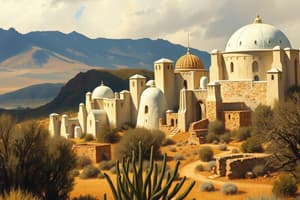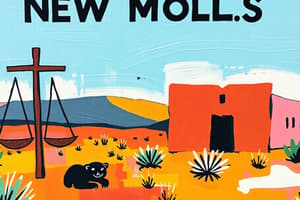Podcast
Questions and Answers
Which of the following tribes originally inhabited the area before European colonization?
Which of the following tribes originally inhabited the area before European colonization?
- Pueblo (correct)
- Iroquois
- Sioux
- Cherokee
What was the capital of New Mexico established during the Spanish colonial period?
What was the capital of New Mexico established during the Spanish colonial period?
- Roswell
- Albuquerque
- Las Cruces
- Santa Fe (correct)
Which key sector does not contribute significantly to the economy of New Mexico?
Which key sector does not contribute significantly to the economy of New Mexico?
- Agriculture
- Oil and Gas
- Manufacturing (correct)
- Tourism
Which of the following agricultural products is a major contribution from New Mexico?
Which of the following agricultural products is a major contribution from New Mexico?
What is one of the main environmental challenges faced by New Mexico?
What is one of the main environmental challenges faced by New Mexico?
Which cultural festival is notably celebrated in New Mexico?
Which cultural festival is notably celebrated in New Mexico?
What is the approximate population of New Mexico?
What is the approximate population of New Mexico?
Which language is not recognized as an official language in New Mexico?
Which language is not recognized as an official language in New Mexico?
Which of the following is not a focus within New Mexico's higher education institutions?
Which of the following is not a focus within New Mexico's higher education institutions?
What significant element is included in the government relations of New Mexico?
What significant element is included in the government relations of New Mexico?
Flashcards are hidden until you start studying
Study Notes
Geography
- Located in the southwestern region of the United States.
- Bordered by Arizona to the west, Texas to the east and south, and Colorado to the north.
- Features diverse landscapes including mountains, deserts, and forests.
History
- Originally inhabited by Native American tribes such as the Pueblo, Navajo, and Apache.
- Became a Spanish territory in the 16th century; Santa Fe established in 1610.
- Became part of Mexico after its independence in 1821; U.S. acquired it in 1848 after the Mexican-American War.
Economy
- Key sectors: oil and gas, agriculture, tourism, and military.
- Major agricultural products: chile peppers, pecans, and cattle.
- Tourism draws visitors to national parks, historic sites, and cultural festivals.
Culture
- Rich blend of Native American and Hispanic influences.
- Notable for its art, especially in Santa Fe known for its Pueblo-style architecture and art galleries.
- Celebrates various cultural festivals, including the Albuquerque International Balloon Fiesta.
Demographics
- Population: approximately 2.1 million.
- Ethnic composition: Majority Hispanic/Latino, significant Native American population, and European ancestry.
- Official languages: English and Spanish.
Education
- Home to several higher education institutions, including the University of New Mexico.
- Emphasis on research and development, particularly in science and technology.
Environment
- Diverse ecosystems ranging from desert to mountainous regions.
- Known for national parks such as Carlsbad Caverns and White Sands.
- Challenges include water scarcity and environmental conservation issues.
Government
- Capital: Santa Fe.
- State government: Governor, state legislature, and judicial system.
- Significant focus on tribal sovereignty and relations with Native American tribes.
Geography
- Southwestern U.S. state, showcasing a variety of landscapes.
- Borders: Arizona (west), Texas (east and south), Colorado (north).
- Features mountains, deserts, and forests, providing diverse ecosystems.
History
- Inhabited by Native American tribes, including Pueblo, Navajo, and Apache.
- Spanish territory established in the 16th century; Santa Fe founded in 1610.
- Became part of Mexico post-independence in 1821; U.S. acquired territory in 1848 via the Mexican-American War.
Economy
- Major economic sectors: oil and gas, agriculture, tourism, military.
- Key agricultural products include chile peppers, pecans, and cattle.
- Tourism thrives on national parks, historical attractions, and cultural events.
Culture
- A rich fusion of Native American and Hispanic cultures.
- Santa Fe notable for Pueblo-style architecture and vibrant art scene.
- Hosts cultural events like the Albuquerque International Balloon Fiesta.
Demographics
- Population approximated at 2.1 million.
- Predominantly Hispanic/Latino, with notable Native American and European ancestry.
- Official languages: English and Spanish.
Education
- Home to significant higher education institutions, including the University of New Mexico.
- Focused on research and development in science and technology.
Environment
- Hosts diverse ecosystems, from deserts to mountainous terrains.
- National parks include Carlsbad Caverns and White Sands, known for their natural beauty.
- Faces challenges such as water scarcity and environmental conservation efforts.
Government
- Capital city: Santa Fe.
- State governance includes a Governor, state legislature, and judiciary.
- Emphasizes tribal sovereignty and maintaining relationships with Native American tribes.
Studying That Suits You
Use AI to generate personalized quizzes and flashcards to suit your learning preferences.




